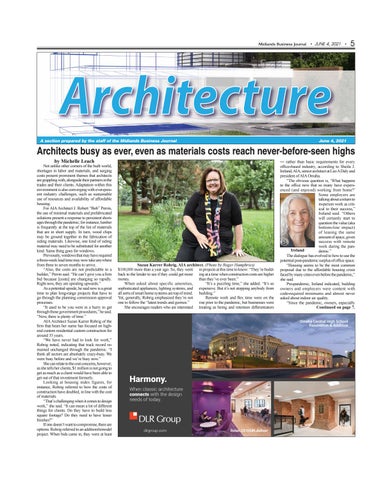Midlands Business Journal • JUNE 4, 2021 •
5
Architecture A section prepared by the staff of the Midlands Business Journal
June 4, 2021
Architects busy as ever, even as materials costs reach never-before-seen highs by Michelle Leach
Not unlike other corners of the built world, shortages in labor and materials, and surging costs present prominent themes that architects are grappling with, alongside their partners in the trades and their clients. Adaptation within this environment is also converging with ever-present industry challenges, such as sustainable use of resources and availability of affordable housing. For AIA Architect J. Robert “Bob” Perrin, the use of minimal materials and prefabricated solutions present a response to persistent shortages through the pandemic; for instance, lumber is frequently at the top of the list of materials that are in short supply. In turn, wood chips may be ground together in the fabrication of siding materials. Likewise, one kind of siding material may need to be substituted for another kind. Same thing goes for windows. Previously, windows that may have required a three-week lead time may now take anywhere from three to seven months to arrive. “Also, the costs are not predictable to a builder,” Perrin said. “He can’t give you a firm bid because [costs] are changing so rapidly. Right now, they are spiraling upwards.” As a potential upside, he said now is a great time to plan long-range projects that have to go through the planning commission approval processes. “It used to be you were in a hurry to get through those government procedures,” he said. “Now, there is plenty of time.” AIA Architect Suzan Karrer Rohrig of the firm that bears her name has focused on highend custom residential custom construction for around 35 years. “We have never had to look for work,” Rohrig noted, indicating that track record remained unchanged through the pandemic. “I think all sectors are absolutely crazy-busy. We were busy before and we’re busy now.” She can relate to the cost concerns, however; as she tells her clients, $1 million is not going to get as much as a client would have been able to get out of that investment formerly. Looking at housing index figures, for instance, Rohrig referred to how the costs of construction have doubled, in line with the cost of materials. “That’s challenging when it comes to design work,” she said. “It can mean a lot of different things for clients. Do they have to build less square footage? Do they need to have lesser finishes?” If one doesn’t want to compromise, there are options. Rohrig referred to an addition/remodel project. When bids came in, they were at least
Suzan Karrer Rohrig, AIA architect. (Photo by Roger Humphries) $100,000 more than a year ago. So, they went in projects at this time to know: “They’re buildback to the lender to see if they could get more ing at a time when construction costs are higher money. than they’ve ever been.” When asked about specific amenities, “It’s a puzzling time,” she added. “It’s so sophisticated appliances, lighting systems, and expensive. But it’s not stopping anybody from all sorts of smart home systems are top of mind. building.” Yet, generally, Rohrig emphasized they’re not Remote work and flex time were on the one to follow the “latest trends and gizmos.” rise prior to the pandemic, but businesses were She encourages readers who are interested treating as hiring and retention differentiators
— rather than basic requirements for every office-based industry, according to Sheila J. Ireland, AIA, senior architect at Leo A Daly and president of AIA Omaha. “The obvious question is, ‘What happens to the office now that so many have experienced (and enjoyed) working from home?’ Some employers are talking about a return to in-person work as critical to their success,” Ireland said. “Others will certainly start to question the value (aka bottom-line impact) of leasing the same amount of space, given success with remote work during the panIreland demic.” The dialogue has evolved to how to use the potential post-pandemic surplus of office space. “Housing seems to be the most common proposal due to the affordable housing crisis faced by many cities even before the pandemic,” she said. Pre-pandemic, Ireland indicated, building owners and employers were content with code-required minimums and almost never asked about indoor air quality. “Since the pandemic, owners, especially Continued on page 7.



